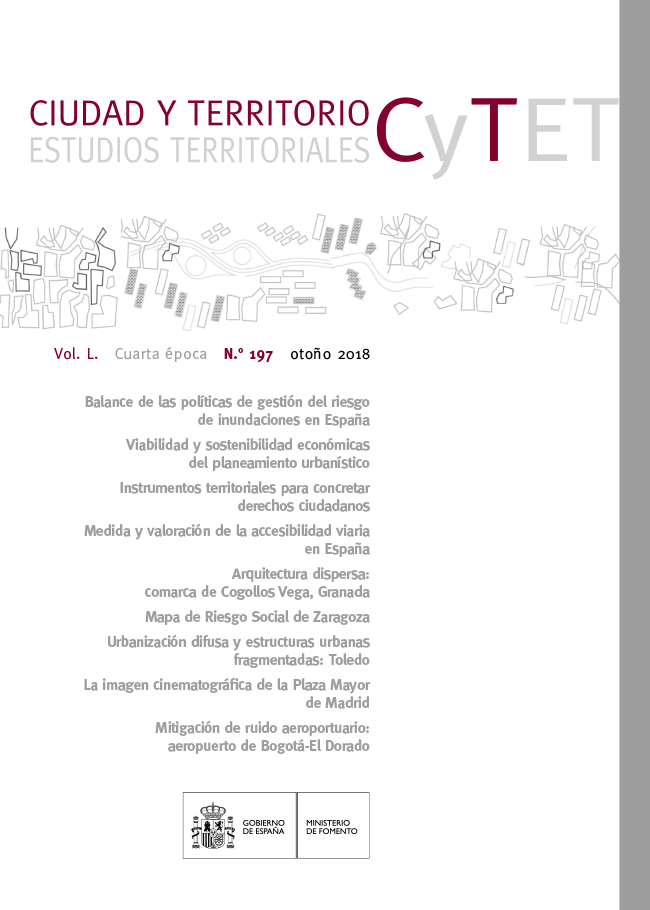An analytical method of dispersed architecture aproach. Study area: Region Cogollos Vega, Granada
Keywords:
Territory, popular architecture, landscape, cultural itineray, heritage valueAbstract
The need for understanding the architectural elements of the environment of the
river Río Blanco in Cogollos Vega in the north of Granada as a territorial and cultural
landscape underlies in its memories and symbolic value, determined by «places with
identity» with a significant role in a global context. These places are worthy of preservation
for their artistic, historical, ethnographic and scenic values. In this region, as in some others,
the notion of heritage must be understood in a holistic way; in a quantitative way, expanding
its conception, and therefore its protection, to the built environment, cultural landscapes
and roads; in a qualitative way, as a tangible and intangible expression of people, as the
«cultural skeleton of the territory». The value assessment of the territory requires analysing
the existing resources from a new perspective and knowing the socio-territorial problems
towards their exploitation. This forces to take a new reading and make an integrated analysis
of the territory through the different types of cultural, environmental, scenic, and
ethnological-anthropological resources and through heritage assessment, in order to define
the relationship of the building and the landscape it is inserted in with features such as
surprise, adaptability, limits, appearance, labyrinthine route, space framework, innovation
and potential, and allowing the evaluation of the use possibilities. Culture plays an important
role and must be linked to a new way of looking and reading, as well as analysing and
diagnosing the territory in order to overcome the simple preservation-recovery of heritage
by its productive reprocessing. The widespread abandonment of popular architecture in this
area, as the country houses in Tejera, Moralejo, Asperones, Dehesilla, La Taula and El Canal,
is understandable taking into account the breaking of the territorial linkages. Therefore, the
development of a biography of unknown architectures, with a greater historical weight, will
allow to assemble and provide the backbone of the heritage in its territorial dimension, as
well as propose preservation solutions and create future multi-active proposals related to
the cultural landscape.
Downloads
Downloads
Published
How to Cite
Issue
Section
License
Copyright (c) 2018 Salvador Ubago Palma, Francisco Lamas Fernández

This work is licensed under a Creative Commons Attribution-NonCommercial-NoDerivatives 4.0 International License.
Considering the provisions of the current legislation on Intellectual Property, and in accordance with them, all authors publishing in CyTET give -in a non-exclusive way and without time limit- to the Ministry of Transport, Mobility and Urban Agenda the rights to disseminate, reproduce, communicate and distribute in any current or future format, on paper or electronic, the original or derived version of their work under a Creative Commons Attribution-NonCommercial-NoDerivative 4.0 license International (CC BY-NC-ND 4.0), as well as to include or assign to third parties the inclusion of its content in national and international indexes, repositories and databases, with reference and recognition in any case of its authorship.
In addition, when sending the work, the author(s) declares that it is an original work in which the sources that have been used are recognized, committing to respect the scientific evidence, to no longer modify the original data and to verify or refute its hypothesis. Author(s) also declare that the essential content of the work has not been previously published nor will it be published in any other publication while it is under evaluation by CyTET; and that it has not been simultaneously sent to another journal.
Authors must sign a Transfer of Rights Form, which will be sent to them from the CyTET Secretariat once the article is accepted for publication.
With the aim of promoting the dissemination of knowledge, CyTET joins the Open Journal Access (OA) movement and delivers all of its content to various national and international indexes, repositories and databases under this protocol; therefore, the submission of a work to be published in the journal presupposes the explicit acceptance by the author of this distribution method.
Authors are encouraged to reproduce and host their work published in CyTET in institutional repositories, web pages, etc. with the intention of contributing to the improvement of the transfer of knowledge and the citation of said works.








 Enlace a CyTET en Linkedin
Enlace a CyTET en Linkedin